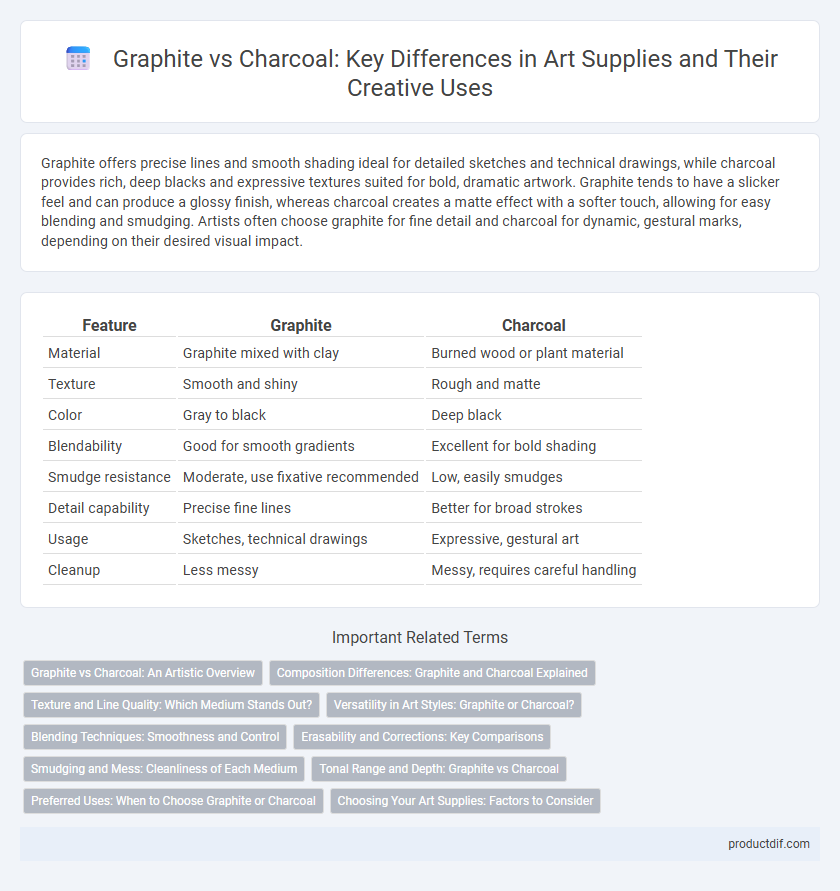Graphite offers precise lines and smooth shading ideal for detailed sketches and technical drawings, while charcoal provides rich, deep blacks and expressive textures suited for bold, dramatic artwork. Graphite tends to have a slicker feel and can produce a glossy finish, whereas charcoal creates a matte effect with a softer touch, allowing for easy blending and smudging. Artists often choose graphite for fine detail and charcoal for dynamic, gestural marks, depending on their desired visual impact.
Table of Comparison
| Feature | Graphite | Charcoal |
|---|---|---|
| Material | Graphite mixed with clay | Burned wood or plant material |
| Texture | Smooth and shiny | Rough and matte |
| Color | Gray to black | Deep black |
| Blendability | Good for smooth gradients | Excellent for bold shading |
| Smudge resistance | Moderate, use fixative recommended | Low, easily smudges |
| Detail capability | Precise fine lines | Better for broad strokes |
| Usage | Sketches, technical drawings | Expressive, gestural art |
| Cleanup | Less messy | Messy, requires careful handling |
Graphite vs Charcoal: An Artistic Overview
Graphite and charcoal are essential drawing materials, each offering unique textures and tonal ranges that influence artistic expression. Graphite provides smooth, precise lines and a wide tonal spectrum from light gray to deep black, making it ideal for detailed work and shading. Charcoal delivers rich, intense blacks and a more textured, expressive quality, favored for bold, dynamic sketches and dramatic contrasts.
Composition Differences: Graphite and Charcoal Explained
Graphite is a crystalline form of carbon composed of tightly packed, layered atoms, providing smooth, consistent marks with a silvery-gray sheen. Charcoal is made from partially burnt organic wood materials, resulting in a porous, brittle texture that produces rich, deep blacks and expressive, textured strokes. These fundamental compositional differences influence their distinct drawing qualities and suitability for various artistic techniques.
Texture and Line Quality: Which Medium Stands Out?
Graphite produces smooth, precise lines with a wide range of hardness that allows for fine details and subtle shading, making it ideal for controlled, clean textures. Charcoal offers rich, deep blacks and a more textured, expressive line quality, perfect for bold strokes and dynamic shading with a rough, grainy finish. Artists seeking detailed work typically prefer graphite, while those valuing dramatic contrasts and textured effects gravitate towards charcoal.
Versatility in Art Styles: Graphite or Charcoal?
Graphite offers precise lines and smooth shading ideal for detailed realism and technical drawings, while charcoal excels in bold, expressive strokes perfect for dynamic sketches and dramatic contrasts. Artists often choose graphite for fine detail and controlled blending, whereas charcoal provides rich texture and deep blacks suited for gestures and impressionistic styles. Both mediums complement diverse art styles, allowing creatives to select based on desired effect and technique.
Blending Techniques: Smoothness and Control
Graphite offers precise blending techniques that create smooth gradients and detailed textures, making it ideal for controlled shading in fine art and technical drawing. Charcoal provides rich, deep blacks and a more expressive blending style, allowing for softer transitions and a more tactile feel, often used in life drawing and expressive sketches. Mastering both mediums enhances artists' ability to manipulate smoothness and control in their compositions.
Erasability and Corrections: Key Comparisons
Graphite offers superior erasability compared to charcoal, allowing artists to make precise corrections with minimal smudging and residue. Charcoal's softer texture often results in more challenging erasing, frequently requiring specialized erasers and careful technique to avoid surface damage. The durability of graphite marks on various papers enhances its suitability for detailed corrections, while charcoal excels in bold, expressive strokes where permanence is less critical.
Smudging and Mess: Cleanliness of Each Medium
Graphite produces less smudging compared to charcoal, allowing for cleaner lines and easier precision in artwork. Charcoal is notorious for its messy nature, easily smudging and leaving residue on hands and surfaces, which can enhance expressive shading but requires careful handling. Artists often use fixatives to preserve charcoal drawings and minimize smudging, while graphite drawings typically need less maintenance for cleanliness.
Tonal Range and Depth: Graphite vs Charcoal
Charcoal offers a broader tonal range and richer depth compared to graphite, allowing artists to achieve intense blacks and dramatic contrasts that enhance shading and texture. Graphite provides smoother gradients and finer control with its reflective surface, ideal for detailed work and subtle tonal variations. The choice between graphite and charcoal depends on the desired effect, with charcoal excelling in bold, expressive artworks and graphite suited for precise, delicate shading.
Preferred Uses: When to Choose Graphite or Charcoal
Graphite is preferred for detailed sketches, technical drawings, and fine shading due to its smooth texture and consistent lines, making it ideal for precision work. Charcoal excels in expressive, bold artworks and gestural drawings, offering rich blacks and a textured finish that enhances dramatic contrasts. Artists choose graphite for controlled, subtle gradations and charcoal when seeking dynamic, intense mark-making to convey emotion or movement.
Choosing Your Art Supplies: Factors to Consider
Graphite offers precise control and a wide tonal range, making it ideal for detailed sketches and fine lines, while charcoal provides rich, bold textures suitable for expressive and dramatic artwork. Consider the surface compatibility, as graphite works well on smooth paper and charcoal excels on textured surfaces that hold the powdery medium. Evaluate your project's needs for blending, erasing, and layering, since graphite is easier to erase and layer finely, whereas charcoal demands fixatives to prevent smudging and allows for more spontaneous, dynamic strokes.
Graphite vs Charcoal Infographic

 productdif.com
productdif.com